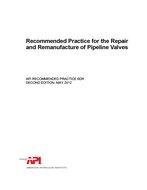No products
 View larger
View larger
API RP 6DR (R2020)
M00043300
New product
API RP 6DR (R2020) Recommended Practice for the Repair and Remanufacture of Pipeline Valves, Second Edition
standard by American Petroleum Institute, 05/01/2012
Full Description
This recommended practice provides guidelines for the repair and remanufacture of steel ball, check, gate, and plug valves normally used in pipeline applications, as defined by API 6D.This recommended practice covers repair or remanufacturing of end user's (owner's) valves for continued service in the owner's production applications. It does not cover repair or remanufacture of used or surplus valves intended for resale.
Repaired or remanufactured valves may not meet API 6D and/or the OEM original product definition (OPD) for new valves.
The owner is responsible for the correct application of valves repaired or remanufactured per this document.
Field repair is outside the scope of this document.
In stock
More info
Recommended Practice for the Repair and Remanufacture of Pipeline Valves
API RECOMMENDED PRACTICE 6DR SECOND EDITION, MAY 2012
REAFFIRMED, JANUARY 2020
Recommended Practice for the Repair and Remanfacture of Pipeline Valves
Upstream Segment
API RECOMMENDED PRACTICE 6DR SECOND EDITION, MAY 2012
REAFFIRMED, JANUARY 2020
Special Notes
API publications necessarily address problems of a general nature. With respect to particular circumstances, local, state, and federal laws and regulations should be reviewed.
Neither API nor any of API's employees, subcontractors, consultants, committees, or other assignees make any warranty or representation, either express or implied, with respect to the accuracy, completeness, or usefulness of the information contained herein, or assume any liability or responsibility for any use, or the results of such use, of any information or process disclosed in this publication. Neither API nor any of API's employees, subcontractors, consultants, or other assignees represent that use of this publication would not infringe upon privately owned rights.
API publications may be used by anyone desiring to do so. Every effort has been made by the Institute to assure the accuracy and reliability of the data contained in them; however, the Institute makes no representation, warranty, or guarantee in connection with this publication and hereby expressly disclaims any liability or responsibility for loss or damage resulting from its use or for the violation of any authorities having jurisdiction with which this publication may conflict.
API publications are published to facilitate the broad availability of proven, sound engineering and operating practices. These publications are not intended to obviate the need for applying sound engineering judgment regarding when and where these publications should be utilized. The formulation and publication of API publications is not intended in any way to inhibit anyone from using any other practices.
Any manufacturer marking equipment or materials in conformance with the marking requirements of an API standard is solely responsible for complying with all the applicable requirements of that standard. API does not represent, warrant, or guarantee that such products do in fact conform to the applicable API standard.
Users of this Recommended Practice should not rely exclusively on the information contained in this document. Sound business, scientific, engineering, and safety judgment should be used in employing the information contained herein.
All rights reserved. No part of this work may be reproduced, translated, stored in a retrieval system, or transmitted by any means, electronic, mechanical, photocopying, recording, or otherwise, without prior written permission from the publisher. Contact the Publisher, API Publishing Services, 1220 L Street, NW, Washington, DC 20005.
Copyright © 2012 American Petroleum Institute
Foreword
Nothing contained in any API publication is to be construed as granting any right, by implication or otherwise, for the manufacture, sale, or use of any method, apparatus, or product covered by letters patent. Neither should anything contained in the publication be construed as insuring anyone against liability for infringement of letters patent.
Shall: As used in a standard, “shall” denotes a minimum requirement in order to conform to the specification.
Should: As used in a standard, “should” denotes a recommendation or that which is advised but not required in order to conform to the specification.
This document was produced under API standardization procedures that ensure appropriate notification and participation in the developmental process and is designated as an API standard. Questions concerning the interpretation of the content of this publication or comments and questions concerning the procedures under which this publication was developed should be directed in writing to the Director of Standards, American Petroleum Institute, 1220 L Street, NW, Washington, DC 20005. Requests for permission to reproduce or translate all or any part of the material published herein should also be addressed to the director.
Generally, API standards are reviewed and revised, reaffirmed, or withdrawn at least every five years. A one-time extension of up to two years may be added to this review cycle. Status of the publication can be ascertained from the API Standards Department, telephone (202) 682-8000. A catalog of API publications and materials is published annually by API, 1220 L Street, NW, Washington, DC 20005.
Suggested revisions are invited and should be submitted to the Standards Department, API, 1220 L Street, NW, Washington, DC 20005, standards@api.org.
iii
Contents
Page
Scope 1
Normative References 1
Terms, Definitions, and Abbreviations 2
Terms and Definitions 2
Abbreviations 2
Preparation for Shipment to the Reconditioner 3
Control of Equipment 3
Disassembly and Cleaning of Valves 3
Evaluation of Components 4
Repair/Remanufacture/Replacement of Valve Parts 4
Control of Manufacturing Operations 4
Inspection of Valve Parts 4
Replacement Parts and Material 4
Fabrication Welding 5
Repair Welding 5
Nondestructive Examination (NDE) 5
Reassembly 5
Final Acceptance 6
Pressure Testing 6
Notification 6
Equipment Marking 6
Nameplates 6
Marking 6
Preparation for Shipment and Short Term Storage 7
Documentation 7
General Documentation 7
Documentation for 2 in. (DN 50) and Larger Valves 8
Annex A (informative) Minimum Requirements for Evaluation and Reconditioning of Parts 9
Bibliography 11
v

